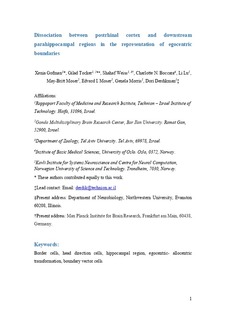Dissociation between postrhinal cortex and downstream parahippocampal regions in the representation of egocentric boundaries
| dc.contributor.author | Gofman, Xenia | |
| dc.contributor.author | Tocker, Gilad | |
| dc.contributor.author | Weiss, Shahaf | |
| dc.contributor.author | Boccara, Charlotte N | |
| dc.contributor.author | Lu, Li | |
| dc.contributor.author | Moser, May-Britt | |
| dc.contributor.author | Moser, Edvard Ingjald | |
| dc.contributor.author | Morris, Genela | |
| dc.contributor.author | Derdikman, Dori Moshe | |
| dc.date.accessioned | 2020-02-17T17:08:59Z | |
| dc.date.available | 2020-02-17T17:08:59Z | |
| dc.date.created | 2020-01-05T07:41:39Z | |
| dc.date.issued | 2019 | |
| dc.identifier.citation | Current Biology. 2019, 29 (16), 2751-2757.e4. | nb_NO |
| dc.identifier.issn | 0960-9822 | |
| dc.identifier.uri | http://hdl.handle.net/11250/2642097 | |
| dc.description.abstract | Navigation requires the integration of many sensory inputs to form a multi-modal cognitive map of the environment, which is believed to be implemented in the hippocampal region by spatially tuned cells [1, 2, 3, 4, 5, 6, 7, 8, 9, 10]. These cells encode various aspects of the environment in a world-based (allocentric) reference frame. Although the cognitive map is represented in allocentric coordinates, the environment is sensed through diverse sensory organs, mostly situated in the animal’s head, and therefore represented in sensory and parietal cortices in head-centered egocentric coordinates. Yet it is not clear how and where the brain transforms these head-centered egocentric representations to map-like allocentric representations computed in the hippocampal region. Theoretical modeling has predicted a role for both egocentric and head direction (HD) information in performing an egocentric-allocentric transformation [11, 12, 13, 14, 15]. Here, we recorded new data and also used data from a previous study [16]. Adapting a generalized linear model (GLM) classification [17]; we show that the postrhinal cortex (POR) contains a population of pure egocentric boundary cells (EBCs), in contrast with the conjunctive EBCs × HD cells, which we found downstream mostly in the parasubiculum (PaS) and in the medial entorhinal cortex (MEC). Our finding corroborates the idea of a brain network performing an egocentric to allocentric transformation by HD cells. This is a fundamental building block in the formation of the brain’s internal cognitive map. | nb_NO |
| dc.language.iso | eng | nb_NO |
| dc.publisher | Elsevier | nb_NO |
| dc.rights | Attribution-NonCommercial-NoDerivatives 4.0 Internasjonal | * |
| dc.rights.uri | http://creativecommons.org/licenses/by-nc-nd/4.0/deed.no | * |
| dc.title | Dissociation between postrhinal cortex and downstream parahippocampal regions in the representation of egocentric boundaries | nb_NO |
| dc.type | Journal article | nb_NO |
| dc.type | Peer reviewed | nb_NO |
| dc.description.version | acceptedVersion | nb_NO |
| dc.source.pagenumber | 2751-2757.e4 | nb_NO |
| dc.source.volume | 29 | nb_NO |
| dc.source.journal | Current Biology | nb_NO |
| dc.source.issue | 16 | nb_NO |
| dc.identifier.doi | 10.1016/j.cub.2019.07.007 | |
| dc.identifier.cristin | 1766326 | |
| dc.description.localcode | © 2019. This is the authors’ accepted and refereed manuscript to the article. Locked until 1/.8.2020 due to copyright restrictions. This manuscript version is made available under the CC-BY-NC-ND 4.0 license http://creativecommons.org/licenses/by-nc-nd/4.0/ | nb_NO |
| cristin.unitcode | 194,65,60,0 | |
| cristin.unitname | Kavliinstitutt for nevrovitenskap | |
| cristin.ispublished | true | |
| cristin.fulltext | postprint | |
| cristin.qualitycode | 2 |

